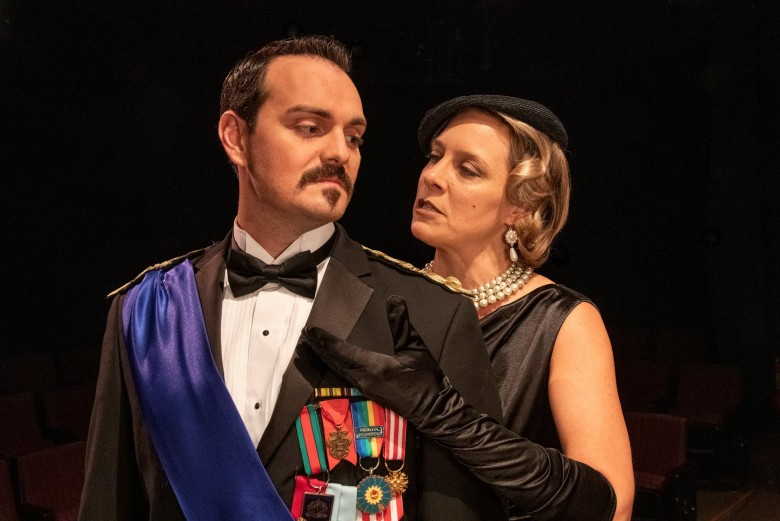“…Beloved, never avenge yourselves, but leave it to the wrath of God, for it is written, 'Vengeance is mine, I will repay, saith the Lord'.” Romans 12, v. 19.
‘Tis a pity that biblical exhortation is not taken to heart by the players in Irish Classical Theatre Company’s season opener, ‘Tis a Pity She’s a Whore, John Ford’s early 17th century tragic tale of incest, betrayal and revenge that ends in torture, death and murder. There is no thought of forgiveness by those wronged in this very absorbing play, only a desire for vengeance that results in complex plotting, often going awry, and retribution for real or imagined betrayers.
Central to the play, as Director Fortunato Pezzimenti says in his notes, is the concept of self-governance vs. bowing to authority. Who has the right to determine one’s fate? Are people to be led in matters of the heart by authority, in this instance the Church, a powerful institution that considers sexual desire to be “that leprosy of lust that rots the soul,” and demands obedience to its tenets of sacrifice and female purity? Or can one break free of societal constraints and live according to one’s own principles and desires?
Set in Parma, Italy, where the Church is the ultimate authority, Giovanni (Jeremy Kreuzer, who begins rather stiffly, but warms to his role and loosens up alarmingly well as events unfold) is a university student in love with his sister, Annabella (Anna Krempholtz, who plays her complex role with charm, wit, passion, and great sadness). He confesses his love to the Friar (Christian Brandjes) and argues his case for personal freedom. The Friar, horrified, instructs him to cloister himself and pray to be freed from his sin, which proves to be an exercise in futility, as he returns more passionate than before. He and Annabella consummate their love, resulting in pregnancy and the full force of the patriarchy falling on her slender shoulders. In the mix are suitors for Annabella’s hand, a woman who betrayed her husband, who then is betrayed by her lover and so plots her own revenge, the husband seeking revenge for her betrayal, a soldier enemy of the lover, a servant with his own agenda, another servant who meets a terrible fate, and so on. Many of these people are killed during the play, and each actor is very believable in those scenes, which could easily have devolved into unfettered melodrama. That they do not is a testament to their skills and that of the Director.
In the midst of this tragic narrative Charmagne Chi as Putana, Anna’s free-spirited companion, Christian Brandjes as the bumbling Signor Donado, and Adam Yellen as the dim-witted and hilarious suitor, Bergetto, skillfully add comic light to the darkness.
Aleks Malejs is excellent as the angry and rather scarily vengeful Hippolita and is quite amusing as the servant Poggio. Adrian Gatto is also excellent as the passionate suitor and ultimate husband of Anna, Lord Soranzo. David Oliver, Ben Michael Moran, Jacob Albarella, Rolando Martin Gomez, and Melinda Capeles round out the fine cast.
A large, bare, three-tiered platform acts as the set, designed by David Dwyer. Its simplicity allows the often-frightening action to unfold unencumbered. Lighting designer Jayson Clarke hung candles suspended by red ribbons from the ceiling, placed them in the corners of the platform and on the floor surrounding it. Red lights dim the stage, giving the impression of blood. The crucifix that hangs overhead throughout the play, and the statue of the Virgin Mary that is paraded through the theater by the entire cast at the outset, are reminders of just who has authority and what that authority demands. Contemporary costumes by Vivian Del Bello add to the personalities of each character, e.g., Hippolita in a clingy black satin gown, Bergetto in silly gold shoes and red jacket, Donado in a rumpled suit he struggles to unbutton.
There are no holds barred in violent scenes, of which there are many. People are thrown across the stage and die excruciating deaths. Choreographer Lauren Nicole Alaimo and Fight Director Adriano Gatto have done a fine job of creating realistic scenes. The knife is the weapon of choice, so there is no shortage of blood, although poison comes into play as well.
“’Tis as common to err in frailty as it is to be a woman,” says Lord Seranzo to the desolate Annabelle, which inspired a loud groan from the opening night audience. While it may seem like an anachronism, one has only to read about current and often successful efforts to control women’s bodies to realize that there are still many changes to be made in that arena.
‘Tis a Pity She’s a Whore, in a fine production, gets down and dirty as it raises questions about morality, obedience to authority, love, lust, and the dark side of the human heart that humans have struggled with since – well, likely since there have been humans.
You can see ‘Tis a Pity She’s a Whore at Irish Classical Theatre Company through October 13th.

